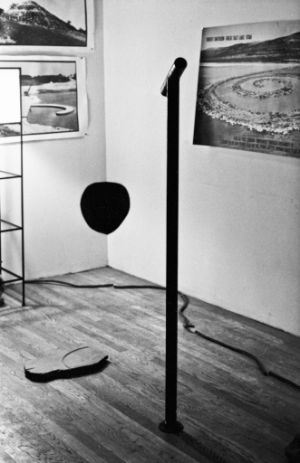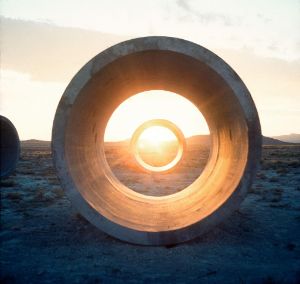Nancy Holt
Digital Guide
The artist Nancy Holt worked with film, video, photography, sound works, concrete poetry, sculptures and expansive installations, as well as drawings and documentation. In the following guide, we’ll introduce you to key aspects of Holt’s practice, inviting you to learn more about an artist who asked us: how do we attempt to understand our place on the surface of this planet?

Nancy Holt filming Sun Tunnels with her Bolex 16 mm film camera, 1976
© Holt/Smithson Foundation, photo: Lee Deffebach
1
The Beginnings
Nancy Holt was born on 5 April 1938 in Worcester, Massachusetts and grew up in New Jersey. She studied biology at Tufts University and graduated in 1960. Later that year, Holt moved to New York City, where she lived and worked in a tight-knit artist community. Her artist friends often appear in her works. In 1963, she married the artist Robert Smithson, with whom she collaborated on many projects.

Nancy Holt, East Coast / West Coast, still, 1969
© Holt/Smithson Foundation
“When looking at something there’s a tendency for certain cards to flip in our brains, certain words to pop up in consciousness — like you see a bird and the first thing you do is name the bird, instead of just being present to the phenomenon of the bird.” — Nancy Holt [1]
2
Language / Early Works
Nancy Holt made her first artworks in 1966 while working as an assistant literary editor at the magazine Harper’s Bazaar. For these works, Holt experimented with language, using it as her material. She changed conventional arrangements of phrases, rearranging sentences, words and letters.
Concrete Poetry
In concrete poems emphasis is put on the way words and symbols are positioned on the paper. Reading a concrete poem, a person is invited to actively participate in the process, following the arrangements of the words and symbols with their eyes.
The works are “concrete poems” and they demonstrate that Nancy Holt had been interested in questioning established systems of how we understand things since the beginning of her artistic career. For example, instead of writing a sentence in one line, with one word followed by another, she chose to arrange words in an order that does not seem “logical” at first glance. This way, words can take on different meanings. Holt's concrete poems can also make us question the ways in which we are used to reading – they can make us question our perception in general.
3
Photography
Nancy Holt used many different means of artistic expression. She experimented with them and often combined them with each other, which you can see in her early photographic series California Sun Signs (1972). While travelling through California, Holt took photos whenever she came across the word “sun”, such as in advertisements on signs. This way, the artist expressed her interest in written language through photography.
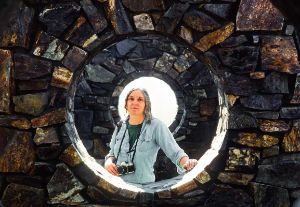
Working with Professor Lawrence Hanson and stonemason Al Poynter among others, Holt constructs Stone Enclosure: Rock Rings at Western Washington University in Bellingham, Washington.
© Holt/Smithson Foundation
Reading the word “sun” in different contexts can encourage us to think about the many different meanings the word can entail. What kind of personal associations do we have with the word “sun”? Do we think about a past holiday? About the changing climate? Does reading it make you feel positive? The photographs can also guide our focus to the space that surrounds the word, sharpening our senses of what we perceive and how we perceive. Holt’s Sun Signs can encourage our awareness of a sense of a place.
4
First Sculptures / Locators
Photography led Nancy Holt to create her first sculptures called Locators – “seeing devices”. These works are made from industrial piping and appear in the shape of the letter “T”. You can look through the Locators with one eye. They frame a particular view by blocking out your surroundings and sharpening your focus on a particular view.
Looking through the Locator, your view is restricted whilst at the same time facilitating a private, solitary experience. Do you feel more aware of your surroundings if your view is restricted? Or does the Locator force you to focus on just what you are actually able to see through the lens?
“The Locator pieces existed to be looked through. Not that I didn’t think about how they looked — I tried different diameters and lengths and heights until I arrived at what was the best visually. Even if you weren’t looking through them, when you looked at them, they immediately signaled sight.” — Nancy Holt [2]
5
Land Art
In 1972, Nancy Holt took the Locators into the rural landscape, bringing them to Missoula, Montana. It was not the first time that Holt explored landscape. A year after she began making art in 1966, Holt created the work Stone Ruin Tour I. She tape-recorded herself dictating a tour through a crumbling labyrinthine garden in Cedar Grove, New Jersey. The artist then transcribed the recording to create an imperfect and unfinished map to explore the site, which was given to her artist friends as a guide.

Nancy Holt and Robert Smithson during construction of Holt’s Missoula Ranch Locators: Vision Encompassed, 1972
Photo: Michael Wheatley
Land Art
Land art emerged during the 1960s and 1970s. Artists often used natural materials like rocks or dirt for their artworks. They worked directly with the land and changed it, for example by creating structures or patterns into the earth. Most of the times, these artworks were created in rural areas. In order to capture their works, artists took photographs or videos of them. The art movement offered artists the possibility to find alternative ways of producing art and express themselves.
This artwork is a great example of Holt using various media for one artwork: she created an audio recording of her voice whilst walking through a landscape. Then she encouraged other people to participate in her artwork by using the recording inspired map as a guide. Finally, she filmed the landscape. Today, Nancy Holt is known as a key Land artist who shaped the movement significantly with her work, continuously questioning the limits of what a sculpture can be. However, the artist herself preferred to be called a “perception artist”.
“The space, and the sky, and the sun just knocked me out. It was a very special experience where I felt that my inside and the outside were identical, somehow. I had been carrying this landscape within me [...] When I came back to New York I was never the same person again.” — Nancy Holt [3]
Site-specific
A site-specific work of art is designed for a specific location. Often, the artwork emphasises the location or features of it. In contrast to artworks travelling from one gallery or museum to the next, site-specific artworks are not looked at independently from their surroundings. The term emerged during the 1970s.
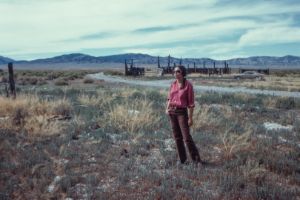
Nancy Holt in Utah, 1971
© Holt/Smithson Foundation / VG Bild-Kunst, Bonn 2023, photo: Robert Smithson
The places in which Holt lived played an important role when creating her site-specific works. New Jersey, the place she grew up, is not only the site of Stone Ruin Tour I but also of Pine Barrens (1975) and Sky Mound (1984–). In 1968, Holt made her first journey to the American West. The space had a profound influence on her artistic practice.
Earthwork
An earthwork is a work of art that is built into a location outside. The term emerged during the 1960s and 1970s as part of the Land Art movement.
The Great Basin Desert in Utah is where her earthwork Sun Tunnels (1973–76) is located. Four concrete structures are arranged in a cross formation, positioned precisely to frame the sun as it rises and sets during the summer and winter solstices. Small holes are configured in the concrete to cast projections of star constellations along the tunnels’ interior. Sun Tunnels is Nancy Holt’s most well-known artwork. In addition to this sculptural earthwork, Sun Tunnels also consists of drawings, photo studies, a film and writings. For example, Nancy Holt considered the documentation of the construction of the artwork to be an artwork in itself.
© Holt/Smithson Foundation
The clip above shows the concrete tunnels for Holt’s Sun Tunnels earthwork as they are transported on trucks shortly after their fabrication to the artwork’s installation site in the Great Basin Desert. In the Sun Tunnels film (1978), Nancy Holt acknowledges and pays tribute to the only way in which this large-scale sculpture was able to come to life: collaboration.
6
Collaboration
Thirty-two people helped Nancy Holt build Sun Tunnels, including engineers, an astrophysicist, concrete pipe company workers and ditch diggers. Inviting people to take part in her works is integral to Nancy Holt's artistic practice.
Throughout her life, it was important to Nancy Holt to invite people to share their understanding of sites with her and to point out the ways in which one’s surroundings can be perceived differently. Perception is an individual act that can change, through elements such as time, point of view and location.
7
Perception
Nancy Holt’s work makes us aware of how we perceive things. In this way, she helps us to understand that there are systems – some human-made, others natural – that we use to navigate the world. How do we move through space, through nature? What is our point of view? What is the relationship between our body and space? How do we position ourselves in this world?
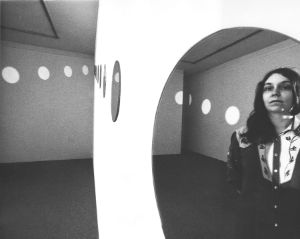
Nancy Holt with Mirrors of Light II at Walter Kelly Gallery, Chicago, Illinois, in 1974
© Holt/Smithson Foundation / VG Bild-Kunst, Bonn 2023; Photo: John R. Bayalis
“Nancy Holt issues a call to pause, observe, and rethink the structures that form our assumptions of the surrounding world” — Lisa Le Feuvre, Executive Director of Holt/Smithson Foundation and Co-Curator of the exhibition Nancy Holt: Circles of Light [4]
8
Circular Shapes
From the lens of the camera Nancy Holt used to capture an image to the viewing-hole of the Locators, circular shapes appear throughout Holt’s work.

Holt completes construction of her most discussed work, Sun Tunnels in Utah’s Great Basin Desert.
© Holt/Smithson Foundation, photo: Ardele Lister, 1976
With the help of circular shapes, Nancy Holt’s artworks frames our views, consciously omitting things that surround us. Often, the artist worked with light, coming from both natural and human-made sources. Holt used light as an artistic tool, paying attention to the interplay between light and shadow.
9
System Works
The work Electrical System (1982) is a network of arching conduits and light bulbs, which winds around the atrium of the Gropius Bau. Holt referred to the work as a “fountain of light” where visitors are invited to step inside. Electrical System is part of a series the artist called System Works. With them, Holt explored human-built environments as a means of revealing the mechanics of technological structures, such as electricity, heat and air. They surround many of us every day, yet they are often hidden behind surfaces.
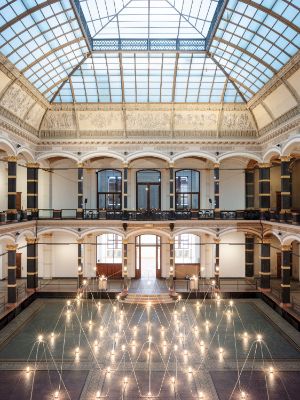
Nancy Holt, Electrical System, 1982, installation view, Gropius Bau, 2024
© Holt/Smithson Foundation, VG Bild-Kunst, Bonn 2024, courtesy: Sprüth Magers, photo: Luca Girardini
Standing inside of installations in the System Works series can also make us think about how different systems connect with each other. For example, Electrical System does not just make us aware of systems of light, but also of systems of movement: how do we navigate our body through the installation?
“With her work, Nancy Holt invites us to pause and direct our attention to the energy we are using on a daily basis. Often without being aware about the environmental consequences we are causing.” — Clara Meister, Co-Curator of the exhibition Nancy Holt: Circles of Light
10
Cosmos
Throughout her life, Nancy Holt encouraged us to pay more attention to the world around us; to think about how we interact with our environments and how we relate to our resources.
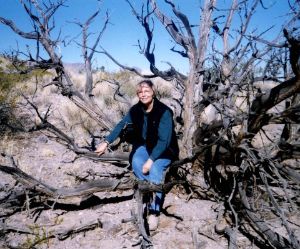
Nancy Holt moves to Galisteo, New Mexico.
Photo: Lucy Lippard, 1998, © Holt/Smithson Foundation
Nancy Holt exposes the systems that structure our lives and our environment. By investigating the act of looking, the artist’s work gives us the chance to think about our connection to the Earth. Do we position ourselves at the centre of it?
“Yet with greater awareness of these systems, the channeling of the energy and elements of the earth can be done intelligently with the long-term benefit of the planet in mind. In doing so we become nature’s agents, rather than aggressors against nature.” — Nancy Holt [5]
The exhibition Nancy Holt: Circles of Light. Experiments with Sound, Image, Objects 1966–1986, curated by Clara Meister and Lisa Le Feuvre, will be shown at the Gropius Bau from 22 March until 21 July 2024. Onthe website of the Holt/Smithson Foundation, you can dive deeper into Holt’s work and read additional information about her life and pratice, including the artist’s own writings.
Endnotes
[1] Nancy Holt from Meyer, James. “Interview with Nancy Holt”, [conducted 7–9 September, 2007]. In Sightlines, edited by Alena J. Williams, 226. Berkeley: University of California Press, 2011, p. 225.
[2] Nancy Holt from Meyer, James. “Interview with Nancy Holt.” In Sightlines, edited by Alena J. Williams, 226. Berkeley: University of California Press, 2011.
[3] Nancy Holt from Gutterman, Scott. “Oralhistory interview with Nancy Holt”, [conducted 6 July, 1992]. For the Archives of American Art, Smithsonian Institution
[4] Le Feuvre, Lisa. “Introduction.” In Nancy Holt: Inside/Outside, edited by Le Feuvre, Pierre, Di France et al., p. 24. Monacelli, 2022
[5] Holt, Nancy. “Ecological Aspects Of My Work.” In Nancy Holt: Inside/Outside, edited by Le Feuvre, Pierre, Di France et al., p. 24. Monacelli, 2022

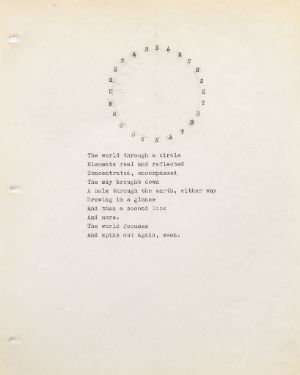

%20(c.%201970).jpg)




